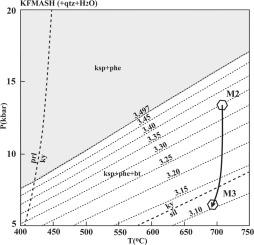Journal of Asian Earth Sciences ( IF 3 ) Pub Date : 2021-03-27 , DOI: 10.1016/j.jseaes.2021.104754 Laixi Tong , Chao Li , Zhao Liu , Mingguo Zhai , Wuxian Li

|
Our recent investigations into the Longyou paragneiss (country gneiss of the Longyou garnet amphibolite) in the northern Wuyi-Yunkai orogen of South China lead to a recognition of high-pressure metamorphic phengites in the paragneiss. The paragneiss consists of phengite, muscovite, biotite, K-feldspar, plagioclase, quartz, and minor graphite and ilmenite or magnetite. Mineral compositions show that Si contents in phengites are between 3.40 and 3.25 (p.f.u., per formula unit), belonging to high-pressure metamorphic phengites. P-T estimates suggest that peak high-pressure metamorphic stage (M2) has P-T conditions of ~ 13.0 kbar and ~ 690 °C, whereas post-peak retrograde stage (M3) has lower P-T conditions of ~ 6.0 kbar and ~ 695 °C. The two-stage P-T conditions define a clockwise P-T path of post-peak isothermal decompression, reflecting a typical collisional orogenic process. SIMS zircon U-Pb age data show a weighted mean 206Pb/238U age of 445 ± 3 Ma, consistent with the metamorphic age of the Longyou garnet amphibolite, suggesting that the peak high-pressure metamorphic event occurred in the Early Palaeozoic orogeny in the Cathaysia block in South China. Thus, we consider that both the Longyou paragneiss and enclosed garnet amphibolite together experienced a phase of high-pressure metamorphism during the Early Palaeozoic continent–continent collisional orogeny likely along the Zhenghe-Dapu fault between the South China block and an unknown block on the northern margin of eastern Gondwana continent.


























 京公网安备 11010802027423号
京公网安备 11010802027423号